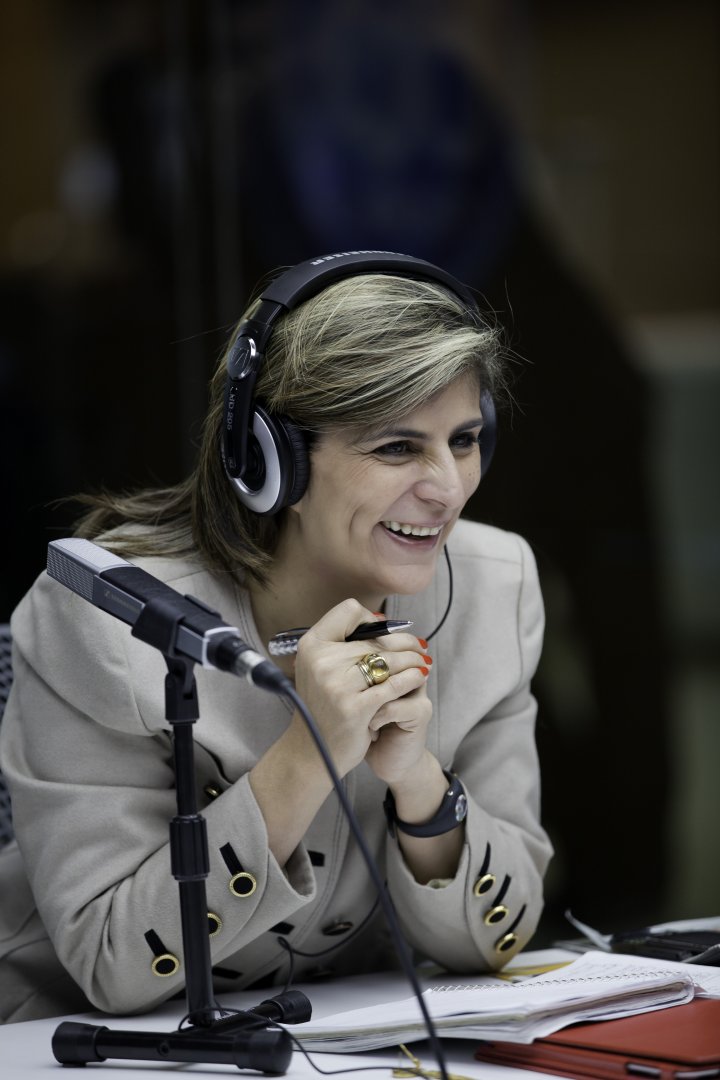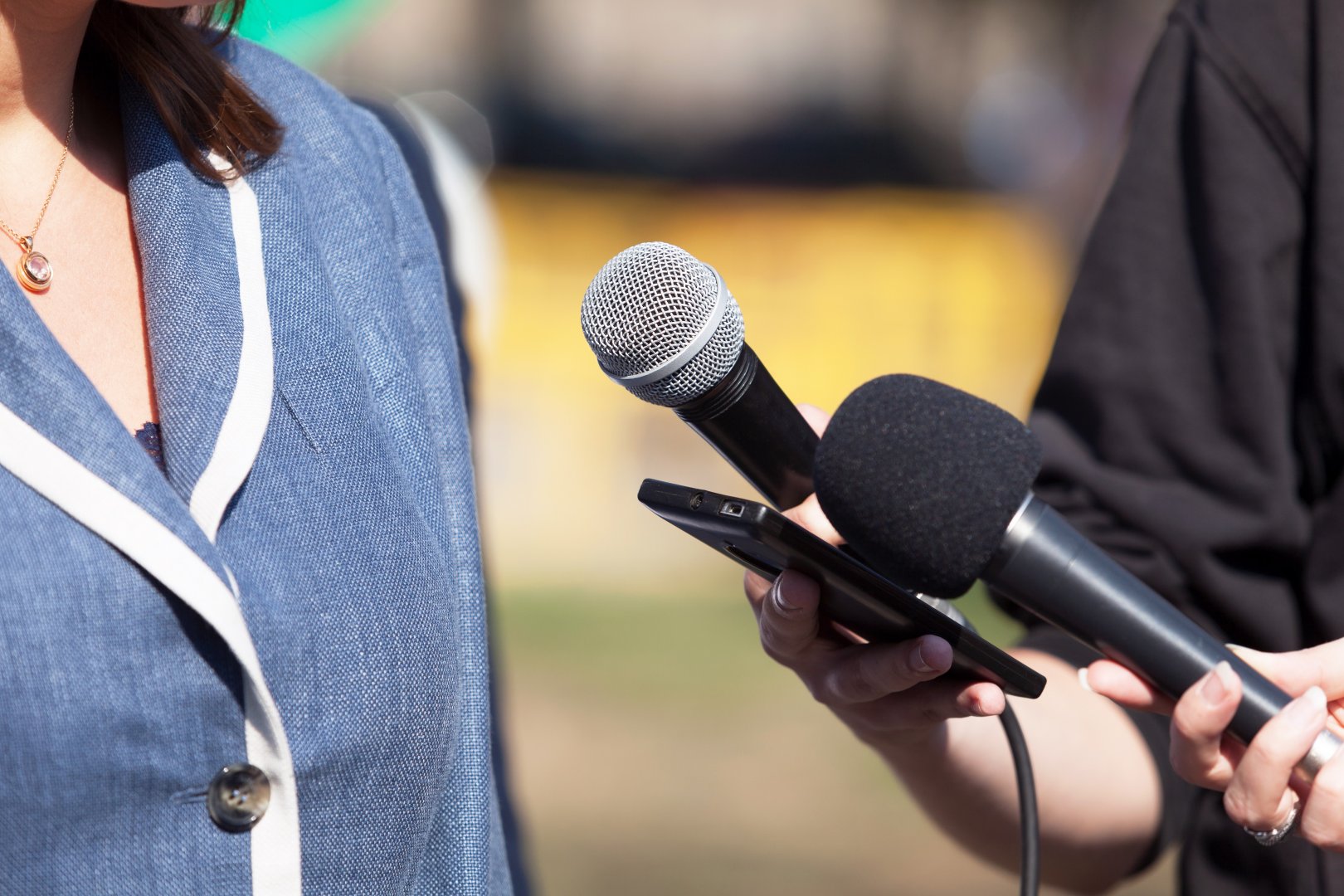
Women and men go to the streets to march for the rights of women on the occasion of International Women's Day in Bogota, Colombia on March 08, 2019. (Photo by Daniel Salgar Antolinez/Anadolu Agency/Getty Images)
Media to support gender equality and peace in Colombia
Peace agreements are more likely to succeed if women participate in the negotiations and implementation processes. Media can support female representation by being conscious about putting women’s voices in the forefront, IMS Colombia advisor Laura Gil explains.
For long-lasting peace in Colombia, it is crucial to include women in the implementation of the peace agreement, and media play a vital role in making sure this happens.
Laura Gil is IMS’ national advisor in Colombia and she firmly believes that: “Media has the power to amplify the voices of women, portray their active roles in peacebuilding, support their participation in public debate, challenge gender stereotypes and hold decision-makers accountable for women rights.” Unfortunately, the media hasn’t realised its potential yet, she explains.
Women’s voices into the limelight
According to the latest numbers, only one in four subjects and sources in Colombian news are women. Three in four journalists in the country are men. In news stories about politics, government, crime and violence, only one in five bring in women representatives.

Altogether, these numbers show a skewed representation of women’s voices and perspectives in the media, and it is an important problem to address because media has a major impact on general perceptions and ideas about the role of women in society – also when it comes to their contributions and legitimacy in conflict resolution and peace building.
Laura Gil believes in the transformative role media can get to play in Colombia: “Media can actively help this process by putting women’s voices at the forefront. With our programme, we are trying to give local journalists the skills and experience to do so,” Laura says.
The overlooking of women in peace processes
In 2012, when the Colombian Revolutionary Armed Forces (FARC-EP) began peace talks with government negotiators in Oslo, no women were included. Laura Gil remembers: “Twenty men and no women. It was a shocking image of exclusion.”
Colombia was in the midst of a conflict between the government and several guerrillas, which had been ongoing for more than half a century. Even though women had been involved – as peacemakers, peacebuilders, victims, change agents, care providers, combatants and supporters of the war – they hadn’t been included on the same terms as men in the peace processes.
That is a grave issue. Conflicts impose increased risks for women of sexualised violence and deepening existing gender inequalities – both during and post-conflict. Yet 95% of peace agreements signed in conflicts countries all over the world in the last 30 years fail to address these threats. 81% of them fail to even mention women at all.
The exclusion of women in negotiations also affects the longevity of peace agreements. The fewer needs and perspectives peace agreements include, the smaller the chances are that they will result in long-lasting peace. When women contribute in security matters and peacebuilding, the agreements are 35% more likely to last at least 15 years.
The power of UN Resolution 1325
The women’s movement in Colombia, supported by the UN, rallied around Security Council Resolution 1325, which promotes the participation of women in peacemaking, and organized to demand women’s participation at the negotiation table and women’s issues in the agenda. Three years later the opening meetings in Oslo, women comprised 20% of the government negotiating team and 43% of FARC delegates. Several delegations of women civil society organizations were received by the parties.
In the end, a commission responsible for mainstreaming the gender perspective throughout the peace agreement was created, and Colombia’s peace agreement became the world’s first to include a gender approach.
Changing bad habits and ways of thinking
The aim of IMS’ programme in Colombia is to engage Colombian media in producing peace and conflict related content from women’s perspective, with a greater inclusion of women in the media.
Colombia is both living in conflict and in post-conflict: in some areas, armed conflict persists; in others, peace building prevails. This situation poses particular problems for the implementation of the peace agreement and has become a challenge for women’s organisations and journalists as well.
One of the focus area of the programme is to connect women’s rights organisations to Colombian media. The organisations can provide the women’s rights expertise, flag issues and provide cases that the media can use in their news coverage. As conflict and gender related content is of a very sensitive nature, the journalists need to know how to handle the information and sources with care.
For this reason, another focus point of the programme is to provide training in gender sensitive reporting for Colombian journalists. The training cover aspects like safety for women journalists, participatory journalism, storytelling, media ethics and guidelines for reporting on violence committed against women.

Overall, the programme wants to change a way of thinking and to give journalists and editors new habits for how they work and what they cover. “One of the most important contributions of the programme is that it will increase the quality of the individual article by simply activating a self-criticism system in the journalists so they will ask themselves: what are my bad habits in terms of gender inclusion and how can I improve my work?,” Laura Gil explains.
Figuring out the problem
Laura Gil has recently started the trainings that focus on a better cooperation between the women’s rights organisations and the media, and they present both new learnings and challenges.
“Recently we had a workshop, and the level of recrimination from both sides took even me by surprise. The session emphasised how much the general issues in media affect a field of coverage like gender and conflict – the shortage of resources and the high number of articles each journalist must produce during a day make it hard for them to cover a case of sexualised violence properly,” she says and continues:
“Sometimes I think that when it goes wrong, it’s due to fatigue more than lack of sensibility. You can’t require from journalists who struggle to publish ten articles a day to be able to set aside the time that dealing with a victim of sexualised violence requires. Their management must be supportive and help create the conditions for them. We have to take all these challenges into consideration in our programme so we can provide ideas for sustainable solutions.”
Slow but steady progress
Luckily, positive changes are happening. The UN, peace and women’s rights organisations have worked strategically with the inclusion of women in peace processes for the last two decades.
“Social change is a slow process, and there’s still much to be done. But I think increasing the collaboration between media and civil society organisations is a significant step. I believe that we can create some important changes that can support the development so we in the future will have a lot more women in the peace process – both around the negotiation tables and portrayed in media – and a lot more women involved in the implementation of peace agreements,” Laura Gil concludes.
Women & conflict – implementing UNSCR 1325 through media
Media poses both challenges and incredible opportunities to increase the inclusion of women in peace processes. International Media Support aims to address the gender gap by increasing women’s participation in peace processes in and through the media.
The country programme in Colombia is part of a larger IMS programme that includes similar initiatives in Myanmar and Syria, two countries also affected by long conflicts. The initiatives in all three countries build on a resolution by the UN Security Council called Resolution 1325 from 2000 which affirms that women’s participation is essential in order to prevent conflict and achieve sustainable peace.
Resolution 1325 urges all actors to increase the participation of women and incorporate gender perspectives in all peace and security efforts. It also recognizes the different experiences of women and men, girls and boys and calls on all parties to take special measures to protect women and girls from gender-based violence, particularly rape and other forms of sexual abuse, in situations of armed conflict.




